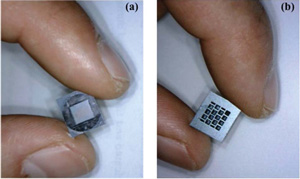Back when I was in sixth grade, I remember reading a little blurb in some science magazine at school that in the future we could receive shots via a method that would feel as soft as a banana peel. Although I’m now a champ at taking shots, it’s still not a bad idea. We’ve had transdermal patches (think nicotine and birth control) for some time now, but those release their medicine over a period of time. A syringe is capable of delivering a dose at once, and can take a biological sample too. Researchers from the University of Pisa have developed this ‘syringe of the future’ within ‘A minimally invasive microchip for transdermal injection/sampling applications’ in Lab on a Chip.
Microsyringe Design
The microsyringe is actually a 0.5 cm x 0.5 cm microchip featuring thousands of hollow silicon-dioxide microneedles. The microneedles are 100 µm long at a density of 1 million needles/cm2. These needles are at least 100 times denser and 10 times smaller than other results reported in the literature. Furthermore, this is not simply a design for microneedles; the researchers have incorporated a reservoir that is meant to store samples from the body and medicine when injecting. The reservoir is comprised of 14 independent volumes adding up to 4.2µL with a sealed plastic cap. The microsyringe would not penetrate as deeply as a normal syringe and would have a smaller total cross-sectional area, resulting in a less painful injection. The researchers intend this microsyringe to be an integral part of an artificial pancreas that is capable of continuously sampling interstitial fluids, measuring glucose levels and releasing insulin to regulate glucose in the blood.

Microsyringe Theoretical Analysis
If the microsyringe is going to be used in the real world, the microneedles need to be able to puncture the outer layers of the skin without breaking. They first tested this theoretically by analyzing the forces acting on the microneedles during insertion. The force required to pierce the skin (derived from a known skin-piercing pressure and the known area of the microsyringe) are compared to the maximum values of the buckling and bending forces that the microneedles would encounter. The buckling force would arise when the microneedle insertion is misaligned with respect to its axis of symmetry (in other words, when the skin isn’t orthogonal to the microneedle cross-section). The bending force is generated by lateral movement between the tissue and needle during the beginning of insertion. The theoretical analysis reveals that the buckling and bending forces are at least 10 times greater than the piercing force, giving it a factor of safety greater than 10.

Microsyringe Mechanical Testing
The researchers followed up this theoretical analysis by simulating insertion into human skin using agarose gel models, which have mechanical properties similar to those of skin. The microsyringes were inserted into the skin at 200 and 500 gram-forces (typical force produced by finger) for 30, 60 and 120 seconds. After repeated insertion tests of the same microneedles, the researchers found that they all penetrated successfully without significant damage to the needles (characterization by SEM). Since this device needs to be able to store liquid, they tested losses due to evaporation and acceleration (ie dropping). Over a 19 day test period, they measured an evaporation rate of 71 nL/min through the microneedles, which would drain the reservoir in an hour. Under acceleration of 80g, the microneedles lost 1320 nL/min, which would drain the reservoir in 3 minutes of falling.

I wonder how the use of this microsyringe would actually work. 4.2 µL is small to begin with, but each individual reservoir is 0.3 µL. It’ll be difficult to load medicine and collect samples. I’m really interested in the group’s plan to use it in an artificial pancreas. A microsyringe by itself is good, but I love the idea of a pancreas. I suppose that one of the most important aspects of the microsyringe is its reservoir size. What’s a relevant medicine payload? What sample size is needed for analysis? I think this is some promising research from this group, and I look forward to reading about their pancreas.
References

Strambini LM, Longo A, Diligenti A, & Barillaro G (2012). A minimally invasive microchip for transdermal injection/sampling applications. Lab on a chip, 12 (18), 3370-9 PMID: 22773092